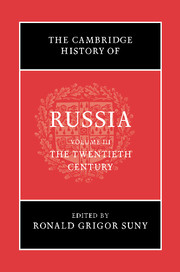Book contents
- Frontmatter
- Introduction
- 1 Reading Russia and the Soviet Union in the twentieth century: how the ‘West’ wrote its history of the USSR
- Part I Russia and the Soviet Union: The Story through Time
- 2 Russia’s fin de siècle, 1900–1914
- 3 The First World War, 1914–1918
- 4 The revolutions of 1917–1918
- 5 The Russian civil war, 1917–1922
- 6 Building a new state and society: NEP, 1921–1928
- 7 Stalinism, 1928–1940
- 8 Patriotic War, 1941–1945
- 9 Stalin and his circle
- 10 The Khrushchev period, 1953–1964
- 11 The Brezhnev era
- 12 The Gorbachev era
- 13 The Russian Federation
- Part II Russia and the Soviet Union: Themes and Trends
- Bibliography
- Index
- References
7 - Stalinism, 1928–1940
from Part I - Russia and the Soviet Union: The Story through Time
Published online by Cambridge University Press: 28 March 2008
- Frontmatter
- Introduction
- 1 Reading Russia and the Soviet Union in the twentieth century: how the ‘West’ wrote its history of the USSR
- Part I Russia and the Soviet Union: The Story through Time
- 2 Russia’s fin de siècle, 1900–1914
- 3 The First World War, 1914–1918
- 4 The revolutions of 1917–1918
- 5 The Russian civil war, 1917–1922
- 6 Building a new state and society: NEP, 1921–1928
- 7 Stalinism, 1928–1940
- 8 Patriotic War, 1941–1945
- 9 Stalin and his circle
- 10 The Khrushchev period, 1953–1964
- 11 The Brezhnev era
- 12 The Gorbachev era
- 13 The Russian Federation
- Part II Russia and the Soviet Union: Themes and Trends
- Bibliography
- Index
- References
Summary
In the late 1920s, the ruling Communist Party of the Soviet Union, under the leadership of its General Secretary, Joseph Stalin, launched a series of ‘socialist offensives’, a revolution that transformed the country. Within a few short years, the USSR bore little resemblance to the country it had been. In the 1920s, the Soviet Union was a minor industrial power, a poor but resource-rich country, based on a large but primitive agrarian network of small-hold peasant farms. By the late 1930s, very few individual farms remained. The country’s agricultural production had been forcibly reorganised on a massive and mechanised scale. Most of the rural population lived on huge state-managed agrifarm complexes. Through state planning and forced investment, industrial production had doubled, then tripled and quadrupled. By the beginning of the Second World War, the Soviet Union had become an industrial military power on the scale of the most advanced countries. The Great Patriotic War, as the Second World War was called, accelerated these modernising processes, and brought about other major changes. The country, which had been nearly 80 per cent rural in the late 1920s, was, by the early 1950s, becoming increasingly urbanised, mobile and educated. Literacy rates had soared as the result of intensive state spending on education. Roads, rail lines, radio and air travel connected the previously isolated parts of the country. Cultures that had had no language boasted their own schools, organised national institutions, written literary traditions and legal status as nations within the Soviet state.
- Type
- Chapter
- Information
- The Cambridge History of Russia , pp. 192 - 216Publisher: Cambridge University PressPrint publication year: 2006
References
- 2
- Cited by



